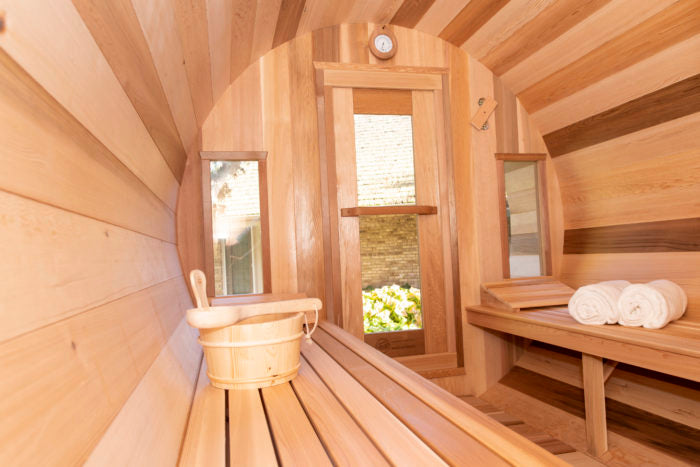Traditional Sauna - Questions
Traditional Sauna - Questions
Blog Article
Facts About Traditional Sauna Uncovered
Table of ContentsThe Only Guide to Traditional SaunaThe Traditional Sauna IdeasIndicators on Traditional Sauna You Need To KnowGet This Report about Traditional Sauna
The majority of the weight shed in a sauna is water loss and is re-gained upon rehydrating. Nonetheless, undeniably sauna can be a vital part of a healthy and balanced weight-loss program. To look at the differences in between typical and IR saunas, I will certainly divide these into verifiable, academic, and produced differences.Hence, the best factor in the saunawhich goes to the ceiling directly above the sauna heateris usually between 185 and 190 F. Traditional Sauna. Claims that a typical sauna surpasses 200 F is simply not true and not applicable for electrical saunas sold in the United States. The temperature for a far-infrared sauna is usually set in between 120 and 140 F; nevertheless, unlike the traditional sauna, the objective in and IR area is not to attain a heat
Due to this, the temperature level distinction is virtually pointless, because extreme sweating causes both sauna kinds, yet the method of warming the body is various. In an IR sauna the bather will certainly feel warm and will sweat profusely, yet at much reduced temperatures. Hence, if the objective is to spend longer time periods in the sauna, the IR sauna is a great selection.

A Biased View of Traditional Sauna
When the high temperature is accomplished, the components cycle on and off to keep the heat. Most typical sauna individuals take pleasure in putting water over the rocks to produce heavy steam to increase sauna humidity levels. The benefits of pouring water over the rocks consist of: making the room much more comfortable, moistening the nasal flows, and permitting the use of aromatherapy by blending crucial oils with the water.
In a far-infrared sauna, the warmth waves penetrate the body to efficiently warm the body and increase the body core temperature. To achieve this increased temperature, Far-infrared emitters develop infrared energy which is close to the same wavelength as that which the body normally emitsoften described as the "Crucial Array" of 7 to 14 microns), so the power is well gotten by the body.
When the power goes into the body, it triggers the body temperature to enhance and inevitably causes sweating. In an infrared sauna it is necessary for the emitters/heaters to continue to be on nearly regularly. Considering that there is no mass of rocks to maintain heat, the sauna will certainly cool down if the emitters turned off.
As mentioned above, the sauna bather in an infrared area intends to position himself before operating emitters to obtain maximum benefit from the heat. The heating time for both spaces can be very various, depending upon exactly how the areas are utilized. For a conventional sauna, a bather ought to allow 30-40 minutes for the area to accomplish a preferred temperature and to properly pre-heat the rocks.
The smart Trick of Traditional Sauna That Nobody is Talking About
A well created sauna will usually attain a temperature of 150-160 F in concerning 30-40 mins (Traditional Sauna). For hotter temperature levels, the room may require to warm for a longer duration. Once the space attains set temperature level, the heating system will cycle on and off, normally running about 50% of the time. The shielded wall surfaces and the warmed rocks will maintain the area warm and at stable temperature levels.
To some, 15 minutes was "lost" while the infrared power heated up the timber panels instead blog of heating a body, while others discover a pre-heated space to be much more comfy and think a raised beginning temperature level is needed to start perspiring. The size of advised use for each space is around the exact same (10-15 minutes per session); nonetheless, as a result of the reduced air temperature levels and the capacity to feel the impacts of infrared warm quicker than a standard sauna, it is not uncommon for a person to spend a total of 20-30 minutes in an infrared sauna.
Conventional saunas tend to be bigger (thus use even more power) than infrared saunas, although typical saunas are absolutely readily available in one and 2 individual sizes. For a two-person traditional sauna, 5x6 or 5x7 dimension is most popular. The top bench can comfortably seat 2 or three people and is also enough time to rest during the sauna session.


The average cost per kWH of power in the U.S. is roughly $0.11, so a 4.5 kW heating system click for more info will set you back approximately $.50 to run for one hour, if the heating system runs constantly for one hour. Usually a sauna heating system will compete 75% of the first hour and 50% of succeeding hours on given that the aspects cycle once the established temperature level is attained.
4 Easy Facts About Traditional Sauna Described
A two person far-infrared room is normally literally smaller sized than a standard sauna, often about 4' x 4' or smaller. The IR furnace is generally 1.5-1.7 kW making use of a 120 volt 15 amp plug-in service. Because the space can be utilized sooner than a sauna room, we will think the area is made use of for to of an hour including heat up time.
There is a seldom reviewed difference in the social experience between the 2 areas. While our culture has actually shed a few of the social benefit of the conventional sauna experience, it can be really socially fulfilling. From family time in the sauna, to heart-felt conversations with significant others, to sauna partiesthe traditional sauna experience can cause intimate mingling.
Most higher end infrared moved here areas include tinted light therapy, noise systems and full-glass fronts.
Report this page